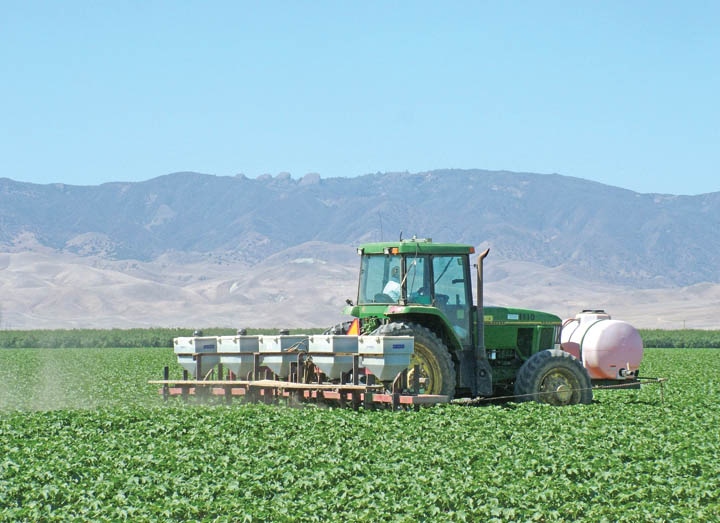
California cotton acreage forecast keeps going up
“Cotton’s Going to be Heaven in 2011,” proclaims California Cotton Growers Association President Earl Williams.Most agree 450,000 acres are realistic. Some say it could reach 500,000 as cotton looks better each day.Growers are splitting tomato beds for cotton and dairymen are looking for a crop to bring in cash.
March 24, 2011

California Cotton Growers Association President Earl Williams has put away his return bus ticket to Arkansas.
Williams jokingly told everyone that he was buying a trip back to his native Arkansas when California’s cotton acreage tumbled to less than 200,000 two years ago. He caught the bus to California in 1958.
Now Williams is waxing poetic: “Cotton’s Going to be Heaven in 2011.”
The acreage keeps rising daily and growers in the Central San Joaquin Valley are anxious to roll the planters. A few did so in early March. On the day of the California Cotton Growers Association annual meeting in Coalinga, Calif., (March 10) cotton was being seeded in Kern County, according to Williams. It was the first day SJV growers could legally plant cotton under the host-free pink bollworm control regulations. Williams said the growers association’s director from Palo Verde Valley in Southern California seeded cotton in the desert on March 1.
The SJV-planted cotton likely struggled to emerge since Degree Day weather forecasts were marginal at best for the week of March 10 and the weather turned miserable from then through the third week in March. Record rainfall was recorded in the valley for the first day of spring.
Williams has raised his California cotton acreage projection 150,000 acres from last fall when he said the state’s acreage would be 300,000 acres, about the same as 2010. He has now increased that to 450,000 and acknowledged that many are saying it could reach 500,000. He is not buying that just yet.
Nevertheless, Williams said, “No one can be happier than me with the turnaround we are seeing. Who could have ever dreamed of the turnaround in prices like we have seen?”
However, cotton merchants and seed salesmen at the meeting say the higher number is becoming more realistic as prices continue to climb. One merchant said one of his clients was splitting 60-inch processing tomato beds into 30-inch cotton beds in March. That is very late, but tomato prices are not going up, and cotton prices are.
A significant percentage of the SJV crop, both Pima and Acala, has been contracted. One report said as much as 50 percent of SJV Pima had been booked before the first seed touches dirt.
A seed salesman said he had calls from tree dairymen the day of the association’s meeting wanting to grow cotton for the first time. They decided they could make more money growing cotton and use the cash to buy dairy feed. New cotton growers are joining returning growers who got out of the business when prices started falling.
As California acreage plummeted, growers sold or scrapped harvesting equipment and gins closed. With the huge acreage rebound from 2009, Williams is concerned about gathering a big 2011 crop.
“We had problems picking in some areas last year with 300,000 acres. If we go to 450,000, it will be an extended season and the cooperation, patience and understanding of everyone will be important. We need to get this cotton stored properly in modules and get modules protected and to the gin. Bad weather can damage cotton, if not stored properly in module yards
“We need to learn from mistakes of last year,” he added.
“There have been some concerns about ginning capacity. I think ginning capacity is there. The ginning industry survived the downturn better than growers with high seed prices. However, ginning capacity is limited, and we will be running 24/7 for an extended period of time to get this crop baled,” he added.
“We have survived the tough times and are now ready to move on as an industry. I am confident we are up to the challenge. Things are good for this industry again,” Williams said.
The Cotton Growers Association’s new chairman, Cannon Michael, Dos Palos, Calif., echoed William’s optimism.
This upturn presents a good opportunity for growers to encourage a resurgence of cotton breeding for the valley, he said.
“We have weathered quite a storm over the past few years. Now it is time to strengthen the industry. These are exciting times. We need to get ready for the time when prices will go down again,” Michael said.
At the annual gathering, the Growers Association recognized Jim Rudig of the California Department of Food and Agriculture (CDFA) for his contribution to the cotton industry with its Distinguished Service Award.
Since 1996, Rudig has been supervisor of the pink bollworm control program in the state. He started working part-time for CDFA in 1962 and eventually moved full-time to the pink bollworm program in 1967. He was based in Kern County then, where the sterile moth release program is headquartered. He later left the cotton program to work in Southern California and the Bay Area on various invasive pests and disease eradication efforts before returning to the Central Valley to work on the grower-funded pink bollworm program.
About the Author(s)
You May Also Like





